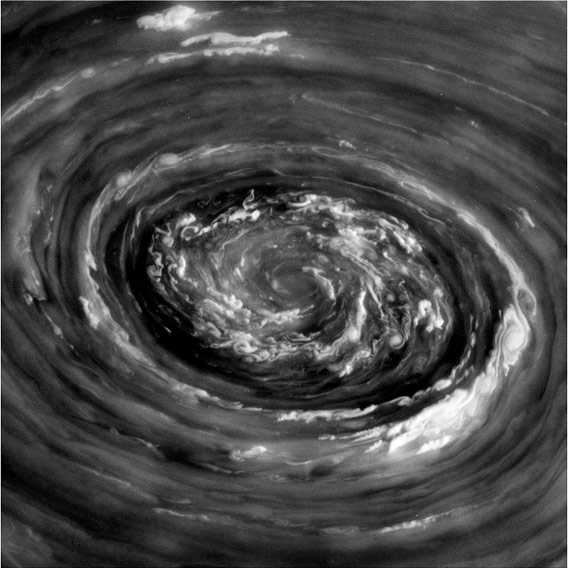Create a free profile to get unlimited access to exclusive videos, sweepstakes, and more!
The Monstrous Eye at Saturn’s North Pole

Saturn is a gas giant planet. That means two things: It has a tremendously thick gaseous atmosphere, tens of thousands of kilometers deep (Earthâs is a mere hundred kilometers in depth, for comparison); and itâs big. So when it does things, it does them on an inhumanly vast scale.
Even knowing this, though, I was unprepared mentally to comprehend this picture taken by the Cassini spacecraft of clouds circling over Saturnâs north pole. Completely unprepared:
Holy Haleakala! Thatâs magnificent!
Saturn rotates once every 10.5 hours, so its day is less than half the length of ours on Earth. When you take all that gas and spin it that rapidly, you get amazing structures in the clouds. This incredible image, taken by the Cassini spacecraft from a distance of about 380,000 kilometers (240,000 miles)âthe same distance the Moon is from the Earthâshows stunning detail in Saturnâs atmosphere. Clouds rise and sink and get stretched out, forming long valleys and ridges, streamers circling the planetâs pole.
This vortex, as itâs called, is huge: over 2000 kilometers (1200 miles) across, if Iâve determined the scale of this picture correctly. Thatâs far bigger than a fully mature hurricane on Earth, but unlike a terrestrial cyclone, this may be a permanent feature in Saturnâs atmosphere.
And itâs in the center of a far-larger, even more astonishing structure called Saturnâs north pole hexagon:
How flippinâ strange is that? The clouds form a six-sided shape that was discovered by the Voyager spacecraft and has persisted for at least 25 years, and is probably much older. Again, itâs huge: 25,000 kilometers (15,000 miles) acrossânearly twice as wide as the entire Earth. You can see the vortex in the very center, dwarfed by the gigantic patterns in the clouds around it.
Why this hexagon-shaped cloud formed is something of a mystery, but experiments in labs on Earth show that polygons (many-sided shapes) can crop up naturally in rotating fluids. Itâs bizarre, but thatâs nature.
By the way, these arenât pictures from last month or a few weeks ago: They were taken yesterday, on Nov. 27! Cassini takes many pictures (and records other kinds of data as well) and then sends them back to Earth. Theyâre archived as raw, unprocessed images, and it can take scientists quite some time to catch up. But these raw images are in a public database, where anyone can look. If you click the pictures here to embiggen them, youâll see there are blemishes due to overactive pixels and other features that are usually cleaned up in the finished product. Quite a few pictures of both the vortex and the hexagon were taken, so Iâm hoping theyâll get cleaned up and prettified soon.
Every December, I collect the best astronomical images of the year for my annual Top Astronomy Pictures article, and I have a strong suspicion that this one will be on that list. Itâs jaw-dropping.
Tip oâ the dew shield to Emily Lakdawalla at The Planetary Society blog. You should have her blog in your feed reader; she's usually on top of all things planetary like this.


























